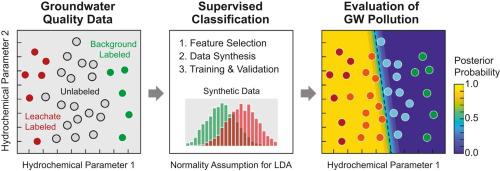Journal of Hazardous Materials ( IF 12.2 ) Pub Date : 2023-05-26 , DOI: 10.1016/j.jhazmat.2023.131712 Junseop Oh 1 , Ho-Rim Kim 2 , Soonyoung Yu 2 , Kyoung-Ho Kim 3 , Jeong-Ho Lee 2 , Sunhwa Park 4 , Hyunkoo Kim 4 , Seong-Taek Yun 1

|
The evaluation of leachate leakage at livestock mortality burial sites is challenging, particularly when groundwater is previously contaminated by agro-livestock farming. Supervised machine learning was applied to discriminate the impacts of carcass leachate from pervasive groundwater contamination in the following order: data labeling, feature selection, synthetic data generation, and classification. Physicochemical data of 359 water samples were collected from burial pits (LC), monitoring wells near pits (MW), pre-existing shallow household wells (HW), and background wells with pervasive contamination (BG). A linear classification model was built using two representative groups (LC and BG) affected by different pollution sources as labeled data. A classifier was then applied to assess the impact of leachate leakage in MW and HW. As a result, leachate impacts were observed in 40% of MW samples, which indicates improper construction and management of some burial pits. Leachate impacts were also detected in six HW samples, up to 120 m downgradient, within one year. The quantitative decision-making tool to diagnose groundwater contamination with leachate leakage can contribute to ensuring timely responses to leakage. The proposed machine learning approach can also be used to improve the environmental impact assessment of water pollution by improper disposal of organic waste.
中文翻译:

一种监督机器学习方法,用于区分尸体渗滤液对农场牲畜死亡埋葬地周围浅层地下水质量的影响
对牲畜死亡埋葬场渗滤液泄漏的评估具有挑战性,特别是当地下水先前受到农牧业污染时。应用监督机器学习按照以下顺序区分尸体渗滤液对普遍地下水污染的影响:数据标记、特征选择、合成数据生成和分类。从埋坑(LC)、坑附近的监测井(MW)、现有浅户井(HW)和普遍污染的背景井(BG)中收集了 359 个水样的理化数据。以受不同污染源影响的两个代表群体(LC和BG)作为标记数据,建立线性分类模型。然后应用分级器评估渗滤液泄漏对 MW 和 HW 的影响。因此,40%的MW样本中观察到渗滤液影响,这表明一些埋坑的建设和管理不当。一年内,六个 HW 样本中也检测到渗滤液影响,下降坡度高达 120 m。用于诊断渗滤液泄漏引起的地下水污染的定量决策工具有助于确保及时应对泄漏。所提出的机器学习方法还可用于改进有机废物处置不当造成的水污染的环境影响评估。用于诊断渗滤液泄漏引起的地下水污染的定量决策工具有助于确保及时应对泄漏。所提出的机器学习方法还可用于改进有机废物处置不当造成的水污染的环境影响评估。用于诊断渗滤液泄漏引起的地下水污染的定量决策工具有助于确保及时应对泄漏。所提出的机器学习方法还可用于改进有机废物处置不当造成的水污染的环境影响评估。











































 京公网安备 11010802027423号
京公网安备 11010802027423号